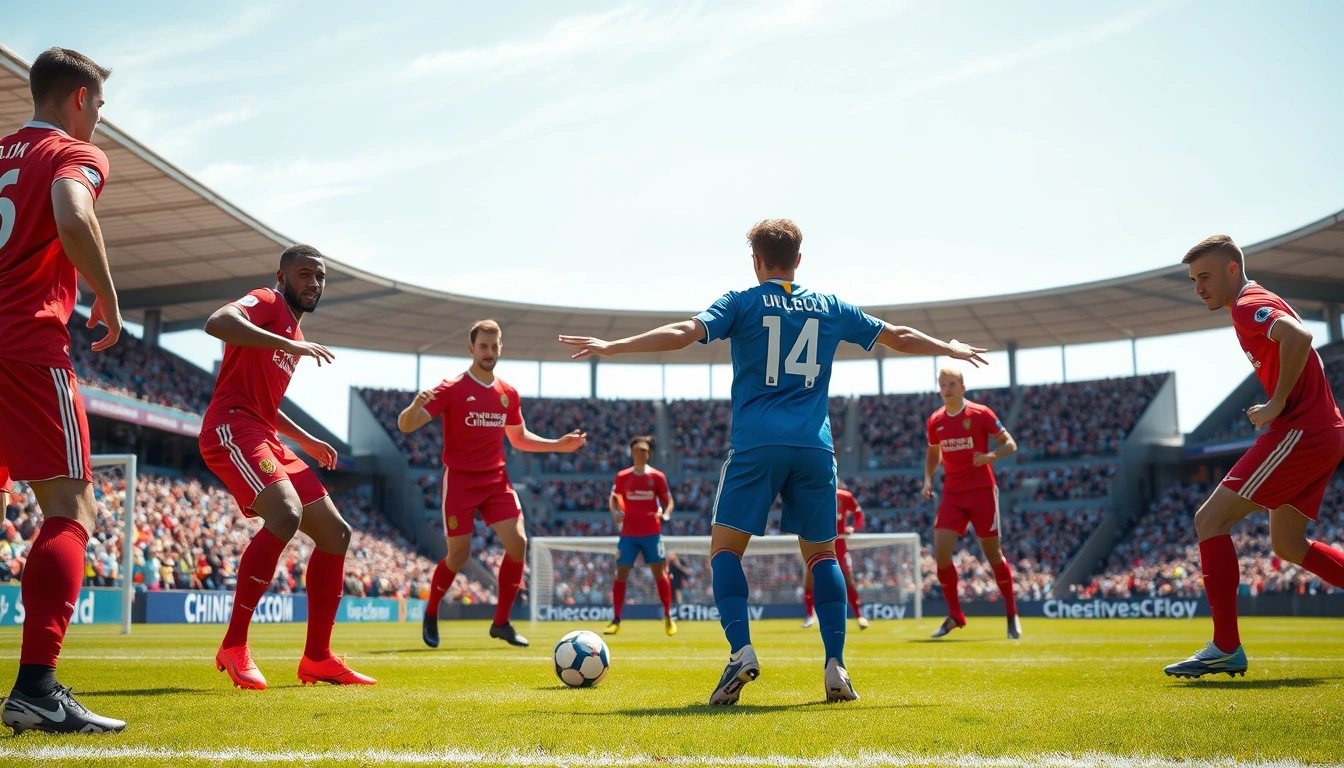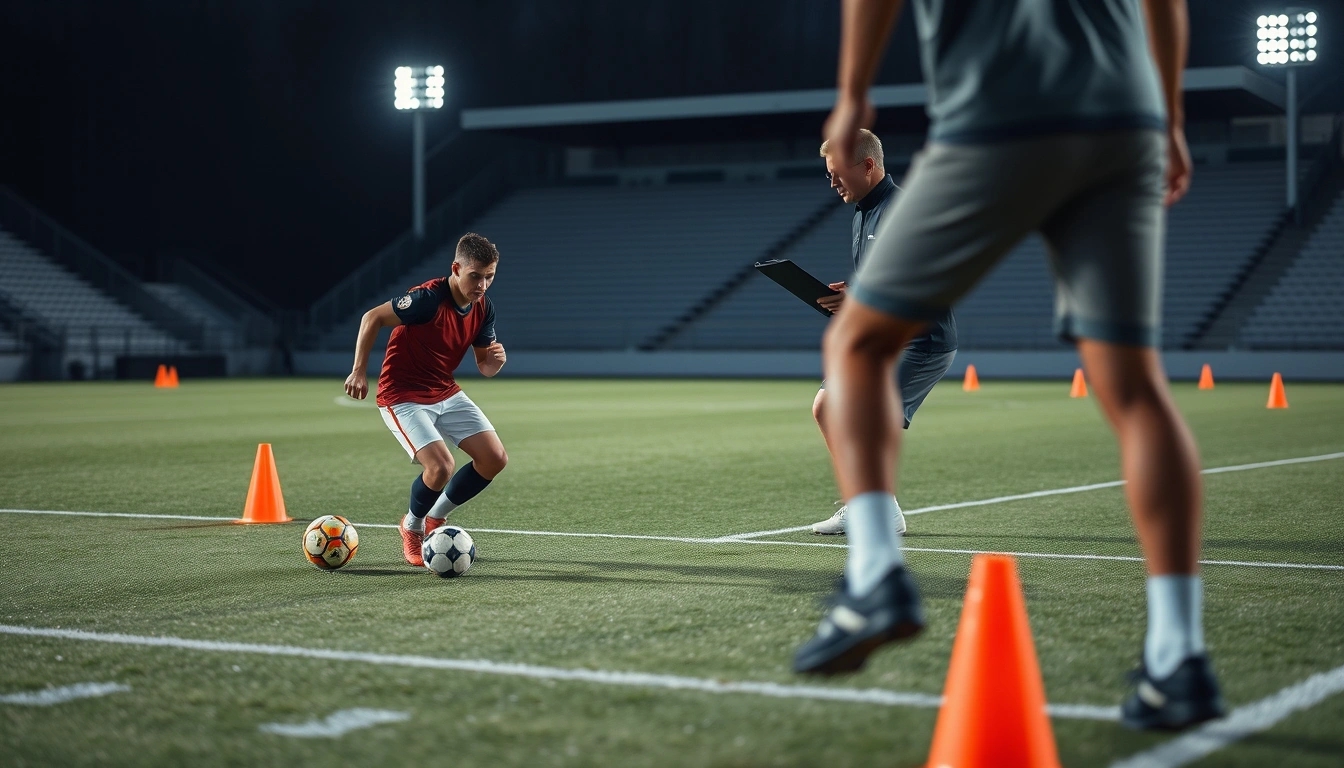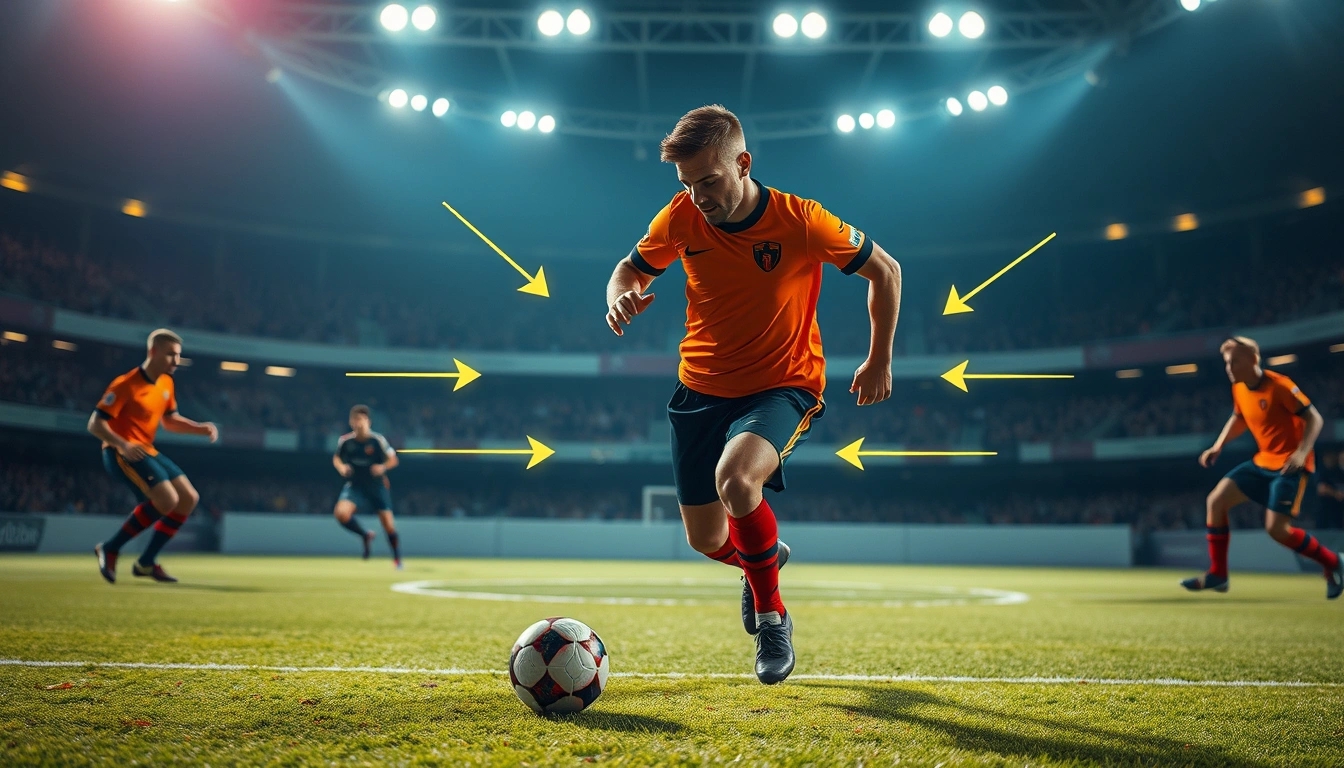Unlocking the secret behind creating space in attack might sound like some mystical art, but trust me, it’s mostly about smart moves and a bit of cheekiness on the pitch. If you’ve ever watched a team just tear apart a defense like it was paper, chances are they nailed these simple yet effective tactics that every player and coach should have in their locker. It’s not rocket science, but it sure feels like magic when it works.
Why Space Matters More Than You Think
Before getting into the nitty-gritty, let’s get real about why space is the holy grail in offense. Imagine trying to park a bus with 11 defenders right in front of you—no room to breathe, no gaps to exploit. Without space, your attack is like a headless chicken running around. But create space? Suddenly, you’re not just attacking; you’re orchestrating a symphony of passes and runs that defenders can’t keep up with.
- Space creates options. More room means more passing lanes, more shooting angles, and fewer defenders breathing down your neck.
- It tires out defenders. They have to cover more ground, get pulled out of position, and eventually crack under pressure.
- Boosts confidence. Players with space feel freer, more creative, and less likely to panic.
Movement Off the Ball: Not Just Fancy Footwork
If you think just standing around waiting for the ball is enough, well, you’re in for a surprise. Smart off-the-ball runs are the real game changers. They confuse defenders, pull them out of shape, and open pockets of space like a magician pulling rabbits from a hat. It’s like chess, but with sweaty players and a ball.
| Type of Off-the-Ball Run | Effect on Defense | When to Use |
|---|---|---|
| Diagonal Run | Pulls defenders sideways | Breaking compact defensive blocks |
| Blindside Run | Exploits unseen gaps | When defenders lose sight of attackers |
| Decoy Run | Lures defenders away | To free up teammates |
Stretching Defenses Wide and Quick Passing
Staying wide and hugging the touchline might sound old school, but it’s a sneaky way to stretch defenses thin. When defenders have to cover more ground horizontally, gaps start appearing in the middle. That’s when midfielders and forwards sneak in like hungry wolves.
And don’t get me started on quick one-twos and give-and-gos. These slick passes are like a slap in the face to tight defenses, making them look like they’re chasing shadows. The key? Speed and timing. Slow passes? Forget it. You’re just handing the ball back to them.
- One-Twos: Pass, sprint, receive. Repeat.
- Give-and-Gos: Fake a pass, then dart into space.
Decoy Runs and Switching Play: The Art of Trickery
Decoy runs aren’t just for show; they’re tactical mind games. By dragging defenders out of position, you create golden opportunities for your teammates to exploit the newly vacated zones. It’s like setting a trap, and your opponents are the unsuspecting mice.
Switching play from one flank to the other is another gem. It’s like flipping a pancake—suddenly, the defense is scrambling to adjust. This quick shift can expose weak spots and create space where none existed before.
Overlaps, Underlaps, and Set Pieces: Bonus Moves
When fullbacks or wingers overlap or underlap, they overload the defense and cause chaos. Defenders get confused: do they track the runner or hold their line? This hesitation is your friend.
Set pieces? Don’t just stand there hoping for a goal. Clever movement during free kicks and corners can carve out valuable space. Think about it: a well-timed run or a smart dummy can be the difference between a tap-in and a wasted chance.
Practical Drills to Boost Spatial Awareness
Here’s a quick drill to get your players thinking:
1. Set up a small grid with cones.2. Assign players to move without the ball, constantly looking for space.3. Add a defender to increase pressure.4. Encourage quick passing and immediate movement.
This drill forces players to find and create space under pressure—exactly what they’ll need in a real game.
In the end, creating space in attack is about being clever, quick, and a little bit sneaky. So get out there, try these tactics, mess up a bit, learn from it, and watch your team’s scoring chances skyrocket.
Understanding the Importance of Space in Attack
Let’s get one thing straight — in soccer, space is not just some fancy buzzword coaches throw around to sound smart. It’s the holy grail of offense. Without space, even the best players can look like they’re stuck in quicksand, struggling to get a shot off or create anything remotely dangerous. And honestly, if your team’s attack feels like a clumsy toddler trying to run, it’s probably because you’re not making enough space.
Think about it: defenders are like hawks circling their prey. They’re always on the lookout, ready to pounce the moment you get too close. So, if you’re crammed into a tiny patch of turf with three defenders breathing down your neck, good luck trying to weave magic. Space gives you breathing room — literally and figuratively. It’s what turns a chaotic scramble into a smooth, clinical finish.
| Why Space Matters | What Happens Without It |
|---|---|
| Allows attackers to receive the ball comfortably | Players get trapped under pressure, leading to turnovers |
| Creates passing lanes and options | Passes become predictable and easy to intercept |
| Confuses defenders by stretching their shape | Defensive lines stay compact, making breakthroughs tough |
Now, here’s the kicker — space isn’t just about standing still in an open field. It’s about creating it through movement, clever positioning, and understanding your teammates’ tendencies. You might be thinking, “Yeah, yeah, sounds obvious,” but the reality is many teams fail to grasp this. They bunch up, chase the ball like headless chickens, and wonder why their attack is as effective as a wet paper bag.
- Space opens up passing options: When you’re spread out, the player on the ball has multiple choices, making it harder for defenders to predict the next move.
- Space gives time: More room means more time to think, control the ball, and pick the right pass or shot.
- Space stretches the defense: Pulling defenders out wide or dragging them forward creates gaps in the middle, prime real estate for attackers.
So, before you start drilling fancy tricks or complicated plays, get this down: space is your offense’s best friend. Without it, you’re just running in circles. With it, you’re setting the stage for goals — lots of them. And hey, if your team’s struggling, maybe the problem isn’t the players’ skill but the lack of space they’re given to work their magic.
Practical Insight:- Encourage players to constantly move off the ball.- Use the entire width of the pitch.- Train players to recognize and exploit pockets of space.
In short, space is the invisible weapon that can transform a sluggish attack into a goal-scoring juggernaut. Get comfortable with it, and watch the magic happen. Ignore it, and well… good luck scoring.
Movement Off the Ball: The Game Changer
When it comes to football, or soccer for our American friends, the spotlight usually shines on the player with the ball. But honestly, some of the most jaw-dropping moments happen because of what’s going on off the ball. You see, smart off-the-ball runs are like secret weapons — they mess with defenders’ heads, open up sneaky little pockets of space, and make the whole attack feel like a well-oiled machine rather than a chaotic scramble.
Now, let’s get one thing straight: defenders aren’t dumb. They’re trained to track players, anticipate runs, and shut down passing lanes. So, if your team’s attackers just stand still or make predictable moves, they’re basically handing the defense a cheat sheet. But here’s the kicker — when players make clever, timed runs away from the ball, defenders have to make split-second decisions. Do they follow the runner and risk leaving a gap? Or do they hold their position and let the player get a free shot? This hesitation is gold.
- Diagonal runs: These confuse defenders because the movement isn’t linear. A diagonal dart into space can split the defense like a hot knife through butter.
- Checking back: Sometimes, players run towards the ball to drag defenders out, then quickly switch direction to exploit the space left behind.
- Blindside runs: Sneaky moves behind the defender’s back, often unnoticed until it’s too late.
| Run Type | Purpose | Effect on Defense |
|---|---|---|
| Diagonal Run | Create passing lanes and split defenders | Causes confusion and forces defensive reshuffling |
| Checking Back | Draw defenders out of position | Creates exploitable gaps behind defenders |
| Blindside Run | Exploit unmarked areas | Surprise element, often leads to goal-scoring chances |
But here’s the thing — these runs only work if the rest of the team is on the same wavelength. Timing is everything. If a forward darts off too early, the pass might be intercepted or called offside. Too late, and the defender has time to recover. It’s a delicate dance, really.
And don’t underestimate the psychological impact. When defenders see attackers constantly moving and switching positions, it’s like trying to catch a greased pig — frustrating and exhausting. This unpredictability can force defenders into mistakes, leaving your team with golden opportunities.
Practical Tips for Off-the-Ball Movement:- Always keep your head up; anticipate where the ball might go next.- Use feints and sudden changes of pace to shake off markers.- Communicate with teammates; a quick shout can synchronize runs perfectly.- Study defenders’ tendencies to exploit their weak spots.
In the end, off-the-ball movement is not just about running for the sake of it. It’s about intelligent positioning and strategic timing. The players who master this become nightmare opponents — they’re everywhere, nowhere, and always a threat. So next time you watch a game, don’t just focus on the player with the ball. Watch the runners off it. That’s where the real magic happens.

Using Width to Stretch Defenses
When it comes to breaking down stubborn defenses, sometimes the simplest tricks are the most effective. One such classic tactic is using width—that is, staying wide and hugging the touchline to pull defenders out of their comfy zones. Sounds straightforward, right? But oh boy, the chaos it can unleash when executed well! Defenders are creatures of habit; they like to stay compact, close ranks, and smother the ball. But when you force them to chase wide players clinging to the sidelines, suddenly the entire defensive shape gets stretched thinner than grandma’s old pizza crust.
Imagine this: your winger is parked near the touchline, practically glued to it, daring a fullback to come and get him. The fullback has no choice but to follow, or else risk giving him a clean shot or a killer cross. But as soon as that fullback steps out wide, gaps start popping up in the middle of the pitch. Midfielders and forwards can then sneak into these openings, exploiting the space that’s just been created. It’s like pulling a thread on a sweater—the whole defense unravels.
- Why does this work? Because defenders hate being stretched. Their instinct is to stay compact and protect the central areas, but wide players force them to make a tough choice: stay tight or chase wide.
- What’s the payoff? More room for creative midfielders to operate and forwards to run into those juicy pockets.
- Bonus tip: When your wide players hug the touchline, it also opens passing lanes for quick switches of play, keeping the defense on their toes.
Now, don’t get me wrong, just sticking wide isn’t a magic wand. It needs support. Your midfielders have to recognize when to dart into those gaps and your forwards should time their runs perfectly. If everyone’s static, well, you’re just wasting space. But when the timing clicks? Oh man, defenders look like they’re chasing ghosts.
| Key Aspect | Effect on Defense | Opportunity Created |
|---|---|---|
| Wide Player Stays Close to Touchline | Draws fullbacks out wide | Central spaces open up for midfield runs |
| Midfielders Exploit Gaps | Defensive shape disrupted | More passing options and shooting chances |
| Quick Switch of Play | Defense forced to shift rapidly | Creates confusion and mismatches |
In practice, coaches drill this constantly. They want players to understand that the width isn’t just about crossing or running down the line—it’s a strategic weapon. Hugging the touchline pulls defenders away from their comfort zones and creates that precious space everyone’s hunting for in attack.
So next time you’re watching a game, keep an eye on those wide players. If they’re smart, patient, and disciplined enough to stick wide, they’re doing half the job of dismantling the defense already. And if your team can exploit that space with sharp midfield runners and clinical forwards, well, the goals will come knocking.
In short: stay wide, stretch ’em out, and watch the defense unravel. It’s a simple tactic with game-changing potential—if you know how to use it right.
Quick One-Twos and Give-and-Gos
Alright, let’s get real about those slick little moves that can totally mess up a defense’s day — the quick one-twos and give-and-gos. If you’re thinking, “Yeah yeah, I know, pass and run,” well, sure, but there’s more to it than just a simple exchange. It’s about timing, precision, and a dash of unpredictability that turns a stagnant attack into a buzzing hive of chaos. Defenders hate it because it forces them to constantly adjust, often leaving gaps wide open like a convenience store at midnight.
Imagine this: you’re in a tight spot, defenders glued to your every move, and suddenly, you whip a lightning-fast pass to your teammate and sprint into the space they just vacated. Boom! That’s the classic give-and-go in action. It’s like a magic trick on the pitch — the ball moves, the defense moves, but you’re always one step ahead. The key? Speed and sharp awareness. You can’t hesitate or dawdle; hesitation is the enemy here. The moment you slow down, defenders sniff it out and clamp down hard.
- Why it works: Quick exchanges disorient defenders, forcing them to make split-second decisions.
- When to use it: Best in tight spaces or when defenses are packed in and refusing to budge.
- Common mistakes: Poor timing, telegraphing the pass, or not committing to the run.
Here’s a little table to break down the anatomy of a killer one-two move:
| Step | What Happens | Why It’s Crucial |
|---|---|---|
| 1 | Player A passes to Player B | Initiates the move and draws defenders in |
| 2 | Player A immediately sprints into open space | Creates a gap in the defensive line |
| 3 | Player B returns the ball to Player A | Player A receives the ball in a better attacking position |
Now, don’t get me wrong — it’s not just about blind speed. There’s a subtle art in reading the defender’s body language, anticipating their move, and deciding when to pull the trigger. If you rush it, you’ll end up with a sloppy pass or worse, a turnover. If you wait too long, the defense snaps back into shape. It’s a razor’s edge, really.
Also, here’s a practical nugget for coaches and players alike: practice these moves under pressure. Set up drills where defenders close down quickly, forcing the attackers to think fast and execute faster. It’s one thing to do a perfect give-and-go in training with no one chasing you, but quite another when a hungry defender is breathing down your neck.
- Drill idea: Two-touch one-twos in a tight grid with defenders applying pressure.
- Focus on: Sharp passing, quick decision-making, and explosive runs.
In the end, mastering quick one-twos and give-and-gos is like having a secret weapon in your attacking arsenal. It’s simple in concept but devilishly effective when executed right. The defense gets rattled, your team gains momentum, and suddenly, that stubborn backline looks like Swiss cheese. So go ahead, practice those lightning passes, commit to your runs, and watch the magic unfold.
Remember: It’s not just about moving the ball; it’s about moving minds — confusing, disrupting, and ultimately, breaking down defenses.
Role of Decoy Runs in Distracting Defenders
When it comes to breaking down a stubborn defense, sometimes the flashiest dribble or the slickest pass isn’t the magic bullet. Enter the decoy run — a move that’s less about grabbing glory and more about serving the team’s bigger plan. Think of it as the classic “look over here, not there” trick, but on the pitch. A player darts off in one direction, pulling a defender along like a reluctant puppy on a leash, while the real action unfolds somewhere else. It’s like a magician’s misdirection, only with shin guards and cleats.
Now, don’t get me wrong, decoy runs aren’t just random sprints or pointless jogging. They require timing, awareness, and a bit of cunning. The player making the run needs to sell it — full commitment, believable intent — otherwise, defenders won’t bite. And if defenders don’t follow, well, the whole plan falls flat. But when executed right, it’s pure gold. The defender chasing the phantom run leaves a gaping hole, a slice of real estate on the field that a teammate can sprint into and exploit.
- Why Decoy Runs Work: Defenders are trained to stick tight, mark their man, and anticipate danger. A well-timed run forces them to make a split-second choice — follow or stay put. This hesitation or movement creates the precious space attackers crave.
- Psychological Warfare: It messes with defenders’ heads. Are they being fooled? Should they switch markers? Suddenly, their focus splits, and that’s when mistakes creep in.
| Decoy Run Type | Purpose | Example |
|---|---|---|
| Straight-line sprint | Pulls center-back out of position | Forward runs deep to lure CB away from goal |
| Diagonal run | Distracts full-back and opens flank | Winger cuts inside, creating space on wing |
| Fake run | Freezes defender momentarily | Player feints run but stops abruptly |
Of course, decoy runs aren’t foolproof. If overused or too obvious, defenders catch on and ignore them. Plus, it demands teamwork — the player making the run must trust teammates to exploit the space, and those teammates must be alert and ready. It’s a dance, really, and if one partner misses a step, the whole routine looks clumsy.
Here’s a little nugget for coaches and players: practice decoy runs during training, but don’t just run for the sake of running. Combine them with quick passes, overlaps, or switches in play. The more varied and unpredictable your attack, the harder it is for defenders to settle.
Tip: When planning a decoy run, ask yourself:- Who am I trying to drag out of position?- Where will the space open up?- Is my teammate ready to exploit that space?- Can I sell this run convincingly?
In the end, decoy runs are the unsung heroes of attacking football. They don’t always get the headlines, but they’re often the reason the goal happens. So next time you see a player sprinting off the ball for no apparent reason, don’t be fooled — that run might just be the key to unlocking the defense.
Remember: It’s not always about who touches the ball last, but who moves smartly enough to create the chance.

Switching Play to Exploit Weaknesses
You know, in the chaotic dance of football, sometimes the best way to unlock a stubborn defense isn’t with fancy footwork or brute force, but by simply switching the play. It’s like shaking a soda can—suddenly, all that built-up pressure explodes into space where you least expect it. When a team clings too tightly to one side, defenders get comfortable, almost snoozing on their feet. That’s your golden ticket to flip the ball to the other flank and catch them flat-footed.
Think about it: defenses often pack the middle or overload the ball-side, expecting the attack to stay put. But when you rapidly switch play from left to right, or vice versa, you’re forcing defenders to sprint across the pitch, scrambling to reorganize. And guess what? They’re not always quick enough. That split-second hesitation creates gaping holes—pockets of space that were invisible just moments before. It’s like magic, but without the rabbits and hats.
- Why is switching so effective? Because it exploits defensive inertia. Defenders rely on positioning and anticipation, and sudden shifts disrupt their rhythm.
- How fast should the switch be? Lightning fast! The quicker you can move the ball across the field, the more likely you’ll catch the opposition off balance.
- Who usually initiates the switch? Midfielders with good vision and passing range, or fullbacks overlapping wide to provide options.
| Key Element | Impact on Defense | Resulting Space Created |
|---|---|---|
| Quick Cross-field Pass | Defenders shift late, creating gaps | Wide areas open for wingers or fullbacks |
| Overlapping Runs on Opposite Flank | Pulls defenders out of central positions | Midfielders find pockets between lines |
| Diagonal Switch with Forward Movement | Confuses marking assignments | Strikers get more space to operate |
But hey, it’s not all sunshine and rainbows. Sometimes, players get too cute with the switch, holding onto the ball for an eternity, waiting for the “perfect” moment. Newsflash: that moment rarely comes. The defense will reset, and your switch turns into a predictable sideways shuffle. So, timing is everything. You gotta catch them just as they’re settling in.
Practical tip? Practice drills that simulate quick switches under pressure. For example, set up a small-sided game where teams must switch the ball at least twice before scoring. It forces players to think laterally and keeps defenses guessing.
Drill: Quick Switch Challenge- Setup: Divide the pitch into two halves.- Objective: Players must switch play from one half to the other within 5 seconds.- Outcome: Encourages fast decision-making and sharp passing.
In the end, switching play is like a secret weapon in your attacking arsenal. When done right, it’s a headache for defenders and a dream for attackers. Just remember: speed, precision, and unpredictability are your best friends here. Keep them off balance, and watch how space magically appears out of thin air.
So next time your team’s attack feels stuck in a rut, don’t just pound the ball forward—try switching it up. It might just be the spark that lights up the scoreboard.
Using Overlaps and Underlaps Effectively
Alright, let’s talk about those sneaky runs down the flank — the overlaps and underlaps — that often make defenders pull their hair out. These movements are like secret weapons in a team’s attacking arsenal, especially when fullbacks and wingers decide to mix things up and overload the defensive line. But, hey, it’s not just about sprinting past your marker and crossing the ball blindly; there’s a bit of art and chaos theory involved here.
First off, what exactly are these runs? An overlap is when a fullback or winger runs on the outside of the teammate with the ball, trying to stretch the defense wider. Think of it as sneaking around the back door while your mate knocks on the front. An underlap, on the other hand, is a bit cheekier — the runner cuts inside, usually between the fullback and center-back, aiming to exploit the space that opens up when defenders shift wide.
| Run Type | Description | Typical Player | Effect on Defense |
|---|---|---|---|
| Overlap | Runs outside the ball carrier to stretch defense horizontally | Fullback or Winger | Pulls defenders wide, creating gaps inside |
| Underlap | Cuts inside between defenders, exploiting central spaces | Fullback or Winger | Confuses defensive marking, opens channels for attacks |
Now, the magic happens when these runs overload the defensive line. Imagine defenders like a line of dominoes — when one gets pulled out of place by an overlapping run, the whole structure can wobble. This chaos creates pockets of space in those juicy attacking zones where strikers or midfielders can slip in and do their thing. But beware! If the timing’s off or the ball carrier hesitates, it all turns into a mess, and the defense quickly snaps back into shape.
- Timing is everything: The runner must start the move just as the ball carrier is ready to pass or dribble forward.
- Communication: A quick glance or nod can save a lot of confusion on the pitch.
- Variation keeps defenders guessing: Mix overlaps and underlaps so opponents can’t predict your next move.
Here’s a little nugget for coaches and players alike: practicing these runs in drills that mimic game pressure can be a game-changer. Set up scenarios where defenders adjust dynamically, forcing attackers to read the situation and decide whether to overlap, underlap, or cut back. The more instinctive these movements become, the more natural they’ll look in real matches.
Drill Example: Overlap/Underlap Reaction Drill---------------------------------------------1. Set up a 5v3 scenario on the flank.2. The 5 attackers must use overlaps and underlaps to break through.3. Defenders adjust their positioning based on the runs.4. Attackers practice timing, communication, and decision-making.
To sum it up, overlaps and underlaps aren’t just flashy runs for show — they’re tactical tools that, when executed well, stretch defenses, create confusion, and carve out precious space. Sure, they require practice and a bit of telepathic connection between players, but the payoff? Goals, chances, and a hell of a lot more fun watching your team dismantle the opposition.
So next time you see a fullback bombing forward or a winger sneaking inside, remember: that’s not just hustle, that’s strategic brilliance in motion.
Set Pieces: A Golden Opportunity to Create Space
When it comes to set pieces in football, most folks immediately think about the ball flying into the net — a cheeky free kick curling past the wall or a towering header from a corner. But, honestly, set pieces are way more than just scoring chances. They’re a brilliant chance to create space — that precious commodity every attacking team craves. If you’re just standing around waiting for the ball, you’re missing half the point. It’s the movement and positioning that really make the difference.
The magic starts before the ball is even kicked. Players have to be clever, almost sneaky, in how they position themselves and move. Think of it like a chess game — you’re not just trying to win a piece, you’re setting up the board to make future moves easier. For example, during corners, some players might make decoy runs to pull defenders out of position, opening up space for teammates to exploit. It’s like a well-rehearsed dance, but with more sweat and less grace.
- Distraction runs: Players sprinting away from the ball to drag defenders with them.
- Blocking: Subtle screens or body positioning to prevent defenders from tracking their marks.
- Timed runs: Breaking free just as the ball is delivered, catching opponents off guard.
And don’t underestimate the power of clever positioning. Sometimes it’s not about sprinting like crazy but knowing exactly where to stand to maximize the chance of receiving the ball or creating confusion. For instance, a player might lurk on the edge of the box, ready to pounce on any cleared ball, or station themselves between defenders to disrupt marking schemes.
| Set Piece Type | Space-Creation Tactic | Effectiveness |
|---|---|---|
| Free Kick | Wall jumps and staggered positioning | High – disrupts defensive wall, opens shooting lanes |
| Corner Kick | Near-post runs and blocking defenders | Medium-High – creates confusion, frees up aerial targets |
| Indirect Free Kick | Quick short passes and decoy runs | Medium – breaks defensive shape, opens passing lanes |
Now, here’s a little secret: set piece routines that look fancy and complicated don’t always work. Sometimes, the simplest moves, like a quick short corner or a subtle dummy run, can throw defenders into a tizzy. It’s all about timing and unpredictability. Defenders hate guessing games, and when they’re unsure who to mark or when to jump, that’s when the space opens up.
So next time you’re watching a game, don’t just focus on the kicker or the header. Watch the players off the ball — the ones darting here and there, nudging defenders, making space out of thin air. That’s the real artistry of set pieces. And if you’re a coach or player, remember: practice those movements, experiment with positioning, and don’t be afraid to get a bit creative. Because in those few seconds of a free kick or corner, you could turn a tight game on its head.
Practical Tips for Players:
- Communicate constantly to coordinate runs and blocks.
- Study opponents’ marking tendencies to exploit weaknesses.
- Practice timing runs with the kicker’s delivery to avoid offsides.
- Use subtle body language to disguise your true intentions.
In the end, set pieces are a golden opportunity — not just to score, but to engineer space where none seems to exist. Nail that, and you’re halfway to winning matches.

Practical Drills to Improve Spatial Awareness
Alright, so you’ve been through all the fancy tactics, the sneaky runs, and the clever passing tricks. But here’s the kicker — none of that really sticks unless players can actually find and create space when it counts, especially when the pressure’s on and the crowd’s screaming like mad. So, let’s get down to some hands-on drills that’ll sharpen those instincts and muscle memory for carving out space in tight spots.
- Shadow Movement Drill: This one’s simple but sneaky effective. Pair up players and have one lead with random movements while the other mirrors them, but with a twist — the follower tries to find a tiny gap to slip through whenever the leader “opens” one. It forces players to constantly scan their surroundings and react quickly to openings. Plus, it’s a bit like a cat-and-mouse game, which keeps it fun and competitive.
- Grid Passing with Pressure: Set up a 10×10 meter grid with 4-5 players inside. The goal? Keep the ball moving with quick, sharp passes while one or two defenders try to close down space and intercept. The attacking players must constantly adjust their positions, use quick turns, and communicate to maintain space. This drill mimics real-game pressure and hones spatial awareness under stress.
Now, if you think drills are just about running around and hoping for the best, think again. They need structure, and here’s a quick table to break down the key elements of spatial awareness drills:
| Drill Name | Focus Area | Duration | Key Benefits |
|---|---|---|---|
| Shadow Movement | Off-the-ball positioning, timing | 10-15 minutes | Improves anticipation and quick decision-making |
| Grid Passing with Pressure | Passing accuracy, spatial adjustment | 15-20 minutes | Enhances teamwork and pressure handling |
But hey, drills aren’t the only way to build spatial smarts. Sometimes, just playing small-sided games with specific rules — like limiting touches or forcing players to switch sides every 30 seconds — can push players to think faster and find space creatively. And don’t underestimate the power of a good ol’ video analysis session. Watching clips of pro players making those split-second decisions to open up space can be a real eye-opener.
- Small-Sided Games: These mini matches create chaos, which is perfect for practicing space creation. Fewer players mean less space, so everyone has to be sharp.
- Video Review Sessions: Use footage to highlight moments when players successfully find or lose space. It’s like a classroom but with more yelling at the screen.
In the end, it’s all about training the brain and body to work together under pressure. Space doesn’t just magically appear; it’s earned through sharp awareness, quick feet, and a bit of cheeky creativity. So get your players moving, thinking, and yes, sometimes fumbling in these drills — because that’s how magic happens on the pitch.
Remember: The best attackers don’t just wait for space. They make it, even when the defense looks like a brick wall. And these drills? They’re the secret sauce to turning that into second nature.
Frequently Asked Questions
- Why is creating space so crucial in attack?
Imagine trying to paint a masterpiece on a tiny canvas — frustrating, right? In football, space acts like that big canvas, giving players room to maneuver, pass, and shoot. Without space, attacks become predictable and easier to defend against. Creating space stretches the defense, making it easier to find gaps and score goals.
- How can off-the-ball movement improve my team’s attack?
Off-the-ball runs are like secret whispers that confuse defenders. When players move smartly without the ball, they pull defenders out of position and open up pockets of space. This unpredictability keeps the defense guessing and creates golden chances for teammates to exploit.
- What’s the benefit of using width in attacking play?
Think of the pitch as a balloon — stretching it wide pulls defenders apart. Hugging the touchline forces defenders to cover more ground, creating gaps in the middle. This tactic makes it easier for midfielders and forwards to find space and launch attacks.
- How do quick one-twos and give-and-gos unlock tight defenses?
Quick passes act like lightning strikes — fast and unexpected. One-twos and give-and-gos disrupt the defensive shape by forcing defenders to react rapidly, often causing confusion and opening up space for attackers to exploit.
- Can decoy runs really make a difference?
Absolutely! Decoy runs are like bait in a fishing game. They lure defenders away from their positions, creating space for teammates to move into dangerous areas. It’s a clever way to manipulate defensive attention without even touching the ball.
- Why is switching play effective in creating space?
Switching play is like flipping a switch in a dark room — suddenly, everything becomes visible. Moving the ball quickly from one side of the pitch to the other catches defenses off guard, opening up new channels and creating space out of seemingly nowhere.
- How do overlaps and underlaps help in breaking down defenses?
Overlaps and underlaps act like sneaky shortcuts around a maze. When fullbacks or wingers make these runs, they overload defensive lines, causing confusion and opening up crucial spaces in attacking zones. It’s all about creating numerical advantages.
- What role do set pieces play in creating space?
Set pieces are more than just goal-scoring chances — they’re strategic moments to carve out space. Clever movement and positioning during free kicks and corners can confuse defenders and open pockets of space, giving attackers a better shot at goal.
- Can drills really improve spatial awareness on the field?
Definitely! Just like a musician practices scales, players can train their spatial awareness with specific drills. These exercises sharpen the ability to spot and create space under pressure, turning good players into great playmakers.










